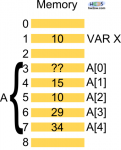
We commonly think to a record like something to be registered or annotated; musical, medical and data recording, and so on.
But structurally... what is a record?
Definition is so simple to result boring: a record is a structure (collection) of different nature data.
In the previous article we saw an important structure called array: a collection of homogeneous data.
An array can host only one kind of data per time: integer numbers or characters or arrays again...
Records offer one more degree of liberty: they can contain integers and chars and arrays... and records as well!
So a sport record is a possible collection of: first and last name (chars or strings), kind of sport (chars or strings) and the performance (typically a number).
Performance is what we commonly intend with sport record, but this is an example of metonymy (yes, we are poets too :)). ...continue reading "By coding a Record"

